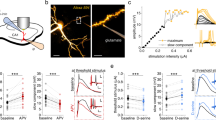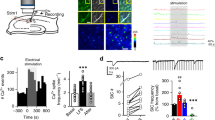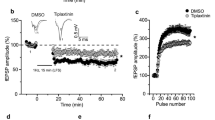Abstract
Bortolotto et al. reply — Nicoll et al. challenge our finding that kainate receptors are involved in mossy-fibre LTP in the hippocampus1. Their argument is based on a discrepancy of our results with earlier work, as we show (our Fig. 5)1 that two kainate-receptor antagonists, kynurenate and CNQX, can also block mossy-fibre LTP. We do not dispute that it may be possible to induce mossy-fibre LTP in the presence of kainate-receptor antagonists under certain conditions. For this reason, we neither stated nor implied that activation of kainate receptors is always necessary for mossy-fibre LTP1.
Similar content being viewed by others
Main
Concerning the resolving power of our experiments, it is important to consider three factors. First, although the effect of CNQX on the induction of LTP had to be assessed three hours after the tetanus owing to the slow washout of CNQX, we often included a non-tetanized input as a control, which also invariably returned to the same, pre-CNQX, level2. Second, in our experiments with the selective AMPA-receptor antagonist GYKI53655, we also had to measure LTP three hours after washout of the antagonist, and LTP was always observed in the tetanized input2. Finally, the kynurenate experiments required only one hour for complete washout.
The relatively low expression of GluR5 messenger RNA in principal cells within the dentate gyrus and area CA3 was not a major concern for us because the relation between GluR5 gene expression and protein levels at this synapse is not known. In addition, as discussed previously3, it is possible that the LY382884 class of compounds can also act on GluR5-lacking heteromeric assemblies of kainate receptors, such as GluR6-KA1, which have not been tested with these antagonists.
The fact that others have observed mossy-fibre LTP in the presence of kynurenate and CNQX has several possible explanations, the most likely being, we suspect, that involvement of GluR5-containing kainate receptors in mossy-fibre LTP can be bypassed in certain circumstances. To determine conditions under which LY382884 might fail to block the induction of mossy-fibre LTP, we have applied multiple trains at test intensity and find that LTP is always blocked by the antagonist; however, when we greatly increase the stimulus strength during the tetanus, some LTP remains2.
Multiple routes for the induction of LTP at CA1 synapses, involving both NMDA4 and mGlu5 receptors, have already been reported. Crosstalk between receptors and their signalling cascades may make LTP more difficult to understand, but it provides synapses with a much richer array of mechanisms with which to build memories.
References
Bortolotto, Z. A. et al. Nature 402, 297–301 (1999).
Vignes, M. et al. Neuropharmacology 37, 1269– 1277 (1998).
Grover, L. M. & Teyler, T. J. Nature 347, 477–479 (1990).
Bortolotto, Z. A., Bashir, Z. I., Davies, C. H. & Collingridge, G. L. Nature 368, 740–743 ( 1994).
Author information
Authors and Affiliations
Corresponding author
Rights and permissions
About this article
Cite this article
Bortolotto, Z., Clarke, V., Delany, C. et al. reply: Kainate receptors and synaptic plasticity. Nature 406, 957 (2000). https://doi.org/10.1038/35023077
Issue Date:
DOI: https://doi.org/10.1038/35023077
This article is cited by
Comments
By submitting a comment you agree to abide by our Terms and Community Guidelines. If you find something abusive or that does not comply with our terms or guidelines please flag it as inappropriate.



